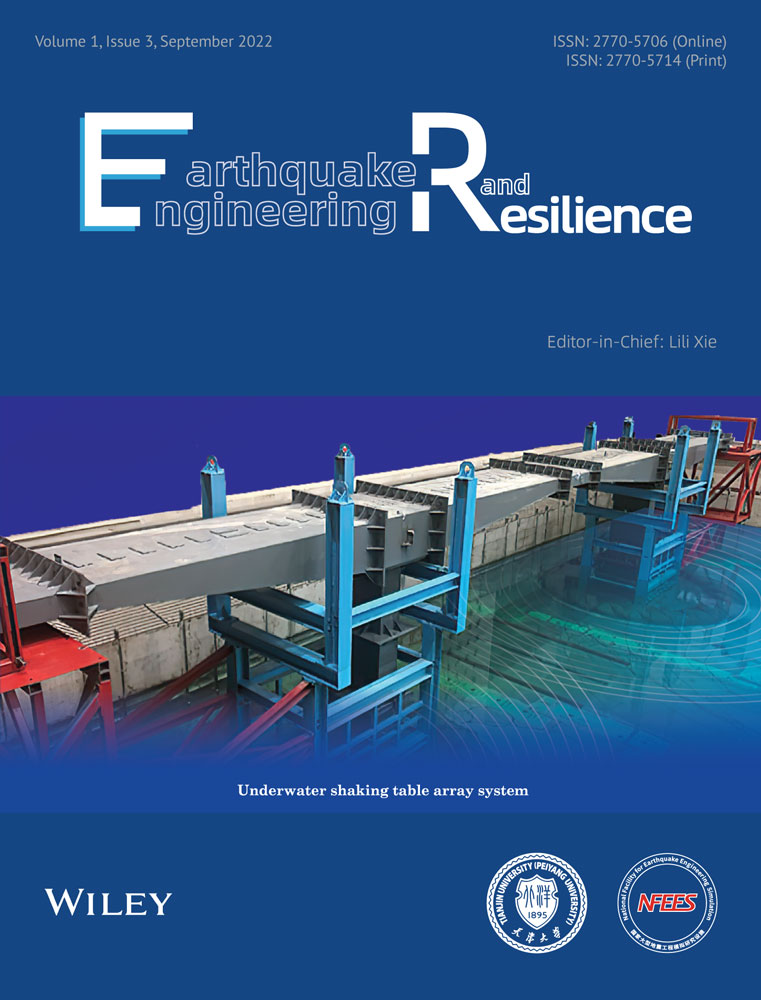A cross validation-Voronoi and entropy based adaptive sampling strategy for uncertainty quantification through hybrid simulation
Abstract
Intensive and complex engineering models drive the need for computational affordability and accuracy. To obtain more accurate prediction, an effective sampling method is proposed and evaluated in this study by integrating CV (cross validation)-Voronoi (CV-V) and entropy (EP) strategies. The new CVV (CV-V) -DEP (Distance and EP) method uses CV-V to divide the sample space into Voronoi units and selects the unit with largest error. The candidate sample point with the largest EP and distance values in the selected unit is then selected. To verify the efficacy of the proposed method, CVV-DEP is first compared with traditional CV-V and CVV-EP (CV-V and EP) strategies for six nonlinear functions. Computational simulations are further conducted using the proposed method for uncertainty quantification through hybrid simulation of two different nonlinear systems. The proposed method is demonstrated to provide great potential for uncertainty quantification of civil engineering infrastructures through hybrid simulation.
1 INTRODUCTION
Design of structural members and systems motivates intensive research for the best engineering performance. However, time and resource consumption of computer simulation are prohibitive for complex engineering models with uncertainty. Meta-models, also known as surrogate models, have been widely used to replace simulation models to minimize their computational demands for design space exploration.1 Meta-modeling thus helps designers evaluate how the decisions made during the design process affect the design's capability to meet engineering requirements. More importantly, the systematic use of meta-models allows designers to understand the impact of different design variables on the engineering responses and find the best design solution for engineering performance. Various meta-models have been developed in literature such as Kriging,2 support vector machine,3 Neural Networks,4 polynomial chaos expansion,5 and radial basis functions.6 Compared with other meta-models, Kriging provides good accuracy in highly nonlinear behavior and can treat the output of unknown function as the realization of a random process and provide the estimated prediction error.7 Normally, the greater the number of samples, the higher the accuracy of the constructed meta-models. Excessive samples however result in high computational cost. It is therefore extremely important to select more important sample points to establish the Kriging meta-model to achieve accurate prediction. Sampling strategies for meta-modeling can be classified into either predefined or adaptive. The former generates all sample points at one time therefore often needs a larger sample size to explore the design space more sufficiently. For example, Monte Carlo simulation (MCS)8 estimates distributions of quantities of interests through repeated simulations with different parameters. Its accuracy depends on the number of samples. Besides MCS, several pseudo-random techniques have also been developed to improve the computational efficiency using low discrepancy samples, such as Latin-Hypercube sampling9 and Sobol sequence.10 Compared with the predefined sampling strategy, adaptive sampling strategies continuously select new sample points based on existing sample set until the precision of the meta-model or the total number of sample points reaches a specified value. The information contained in the sample itself is accounted for therefore fewer sampling points are required to obtain a more accurate meta-modeling.
The challenge in adaptive sampling strategies is how to choose the new sample point based on information obtained from experiments with previous sample points. Many methods focus on the information contained in the sample itself, select new sample points and determine whether they are convergent based on the nature of the sample itself. Efficient global optimization (EGO) of expensive Black-Box functions11 uses generalized expected improvement function to update the Kriging model. Sasena et al.12 later increased the flexibility of EGO algorithm through additional filling sampling standard. Echard et al.13 proposed the AK-MCS method based on the U-learning function for reliability analysis. However, the prediction variance provided by Kriging model only depends on the location of the sample, ignores the characteristics of the target model, and has no direct dependence on the response of interests. Therefore, it often leads to low prediction accuracy in complex fitting problems.14 Cross validation-based approach utilizes leave-one-out error to identify regions of strong nonlinearity. Existing meta-model is used to predict the response on those leave-out points and then to calculate the difference between the prediction and the real response.15 The balance between global exploration and local exploitation is an important factor for the effectiveness of an adaptive sampling strategy.16 Cross validation approaches are useful for identifying locally important locations but are not friendly for global exploration. Xu et al.17 combined cross validation with Voronoi concept to formulate the CV-Voronoi method which elects the point farthest from the center point of the selected Voronoi unit.
In Voronoi cells, the distances between the sample points on the cell boundary and the center point are not very different, but the direction of the connection between the sample points and the center point is significantly different. Therefore, it is better to account for more information than the distance within the selected Voronoi unit. This can be complemented by introducing other quantities to select more informative sample points. Entropy (EP) is often used to quantify the “amount of information”18 and has been introduced for the design of computer experiments under the Bayesian framework.19 EP-based strategy however requires that all candidate points be evaluated for each sampling process, which severely limits the efficiency of adaptive sampling. In this study, the traditional cross validation (CV)-Voronoi approach is integrated with EP to formulate a new adaptive sampling strategy for global meta-modeling. This proposed approach, referred to as cross validation-Voronoi distance and entropy (CVV-DEP) hereafter, first divides the entire sample space into different Voronoi units and selects the cell with largest error t based on cross validation. The values of EP are calculated for all candidate samples in the selected Voronoi cell. The sample point is selected for both largest value of EP and farthest from the center point. The amount of information brought by the candidate sample provides the guidance when selecting the new sample point in the selected unit to expedite the sampling process. The cross validation-Voronoi (CV-V) approach however considers the distance between samples. For comparison, another sampling method is also explored which only considers the EP values of candidate samples in the selected Voronoi cell and is referred to as cross validation-Voronoi and entropy (CVV-EP).
In addition to improve adaptive sampling in the establishment of the Kriging meta-modeling, the acquisition of true responses for different design parameters also becomes the key to uncertainty quantification and structural optimization design. The responses of structural members or systems are often obtained through independent field experiments or numerical simulations. Results from numerical simulations often differ from measurements of real systems due to modeling errors, while field experiments are limited by laboratory conditions and costs. Hybrid simulation treats critical and/or complex components that are difficult to numerically model as experimental substructures, while the rest of the system is often easy to model and analyze as numerical substructures.20, 21 Due to the advantages of hybrid simulation, many studies have focused on numerical substructure and experimental substructure boundary correction,22 compensation techniques for reducing actuator delay,23 identification and modification of structural parameters for hybrid simulation model update methods,24-27 Internet-integrated geo-distributed real-time hybrid simulation platform,28 force and displacement hybrid control strategies for solving multifreedom strong coupling problems.29 These have made the hybrid simulation technique widely used in engineering30, 31 to be applied to the assessment of seismic performance of more complex and large engineering structures.32
There has been considerable engineering practice in traditional meta-models for the uncertainty quantification in hybrid simulation. Tsokanas et al.33 used the lambda surrogate model to replace the hybrid simulation response and confirmed the effectiveness of the proposed hybrid simulation global sensitivity analysis framework. Ligeikis and Christenson34 combines real-time hybrid simulation (RTHS) and Kriging to metamodel the frequency response functions of a two degree-of-freedom mass-spring system to estimate distributions of the system response. Yu et al.35 applied the CV-V sampling method to multiresponse RTHS and used the validation test to test the accuracy of the meta-model. Chen et al.36 further used multifidelity Co-Kriging as a global meta-model for hybrid simulation experiments, which achieved accurate predictions with fewer samples. By obtaining the real structural response through hybrid simulation and quantifying the effect of structural uncertainty by Kriging model, the key issues of prohibitive cost of acquiring actual structural responses through large number of laboratory experiments were solved. This study compares the sample selection between CVV-DEP, CVV-EP, and CVV through computational simulation, and further numerically evaluate the CVV-DEP strategy for hybrid simulation. The rest of this study is organized as follows. In Section 2, the formulation of the CVV-DEP strategy is introduced. Six different numerical examples are used to evaluate the proposed method in Section 3. In Section 4, the proposed CVV-DEP is further applied to numerically evaluate its effectiveness for uncertainty quantification through hybrid simulation.
2 FORMULATION OF CVV-DEP ADAPTIVE SAMPLING STRATEGY
2.1 Basics of kriging meta-modeling
2.2 Adaptive sampling-based CV-Voronoi approach
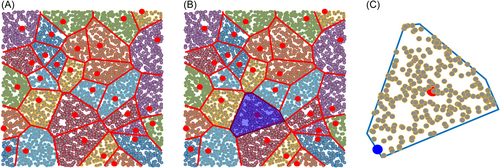
In the cell with the largest error, the point farthest from the center cell in the whole cell is selected to accelerate the cell division process in the entire sample region to achieve a better balance between global prediction and local prediction as shown in Figure 1C.
2.3 Basics of EP
2.4 Formulation of CVV-DEP and CVV-EP adaptive sampling strategies
Figure 2 shows the schematics for the CVV-DEP adaptive sampling. It can be observed in Figure 2C that the sample with balanced distance and entropy is not necessarily same as those with maximum entropy or largest distance. Based on the principle of combining CV-V and EP approach, Figure 3 shows the flow chart of CVV-DEP sampling strategy.
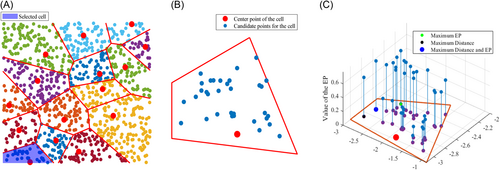
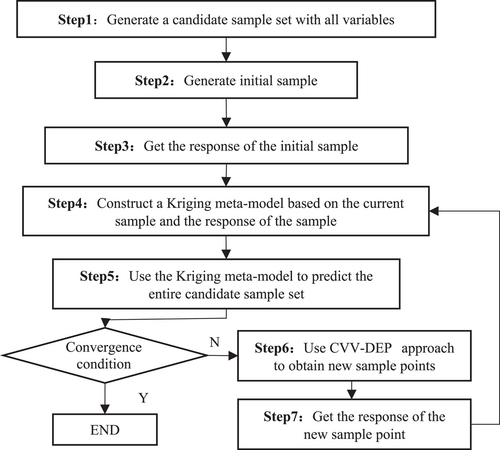
3 EVALUATION OF CVV-DEP FOR NONLINEAR FUNCTIONS
To demonstrate the significant advantages of the CVV-DEP adaptive sampling method, six numerical examples are used for verification and comparison. Numerical examples range from simple to complex, including polynomials, exponential functions, trigonometric functions, and their various combinations.
3.1 Nonlinear functions
Six functions are selected to evaluate the effectiveness of the proposed method, which are given as following
These functions represent different nonlinear behavior as shown in Figure 4. F1 function is a relatively simple binomial. F2 function is a more complex polynomial and is relatively flat in the middle of the entire region with strong nonlinear around. F3 function is relatively flat around and has strong nonlinearity in the middle. F4 function in the whole region is almost zero, but it shows drastic changes in the angle. F5 function has periodic oscillation; F6 function oscillates evenly around and has a low peak in the center.
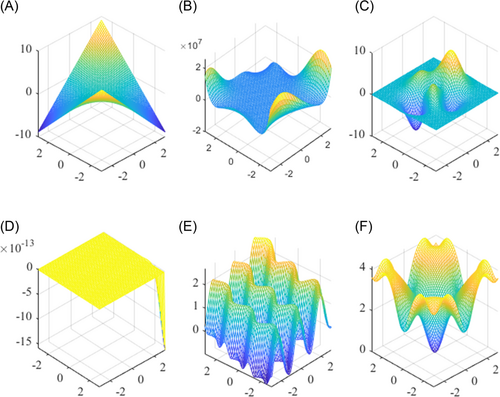
To better illustrate the sample selection processes for CV-V, CVV-EP, and CVV-DEP, take the F3 function as an example. Assume five initial sample points through Latin hypercube sampling. Figure 5 shows the partition of entire space by initial sample points into five Voronoi cells. For comparison, a total of 10,000 validation points is used to compare the accuracy of Kriging meta-models from different sampling strategies, and RMSE smaller than 0.01 is used as convergence criterion.
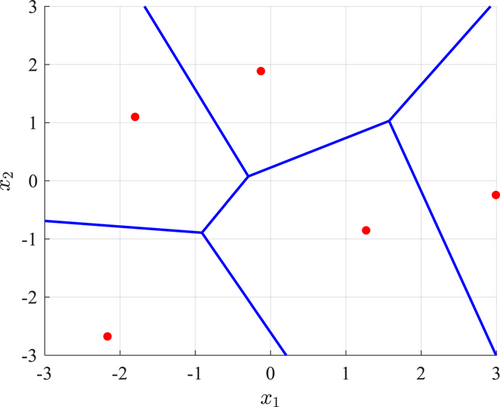
Figure 6 presents the selection process of four additional samples using the proposed adaptive CVV-DEP strategy. For each step, the sample points selected by CV-V and CVV-EP strategies are also included for the purpose of comparison. Figure 6A shows different sample points for largest EP and largest distance. This implies that the CV-V and CVV-EP strategies will lead to different sample point even though same initial sample points are used. The CVV-DEP strategy balances the EP value and the distance which leads to the same point from CV-V. It can also be observed in Figure 6A that the EP value presents a funnel shape around the center point of the Voronoi cell, which has zero EP value is zero. For the second selected sample, the EP value in Figure 6B shows wavy variation for the selected cell with zero at the center point. The sample points selected by all three strategies are the same. Similar observation can be made in Figure 6C as that in Figure 6A, where CV-V and CVV-DEP select the same point but different that from CVV-EP. The variation of EP value in the cell however is observed to be smoother around the center than that observed in Figure 6A. The fourth additional samples selected by three strategies are shown to be different in Figure 6D. The variation of EP value in Figure 6D is observed to continuously change and differ from those in Figure 6A–C. Figure 6 clearly demonstrates the differences between the three CV-based strategies.
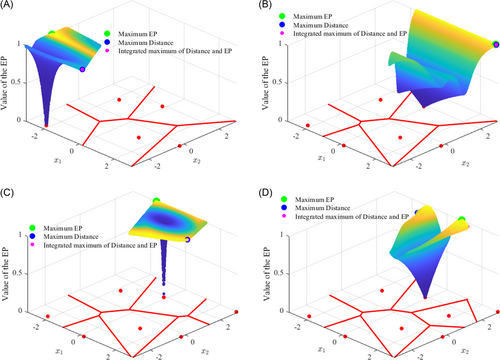
Figure 7 presents the variation of distance between selected sample and the center in the Voronoi cell CVV-DEP and CV-V methods. It is worth noting that the CVV-EP does not utilize the distance for sample selection therefore is not presented. It can be observed that, although CVV-DEP accounts for EP value, but its maximum distance decreases in the same trend as that of CV-V. Under the same convergence criterion, the CV-V strategy has almost same distance as that of CVV-DEP, indicating that the multiple learning times of CV-V eliminates the differences of each selected sample unit, promoted the units of each sample to be more uniform, but reduced the differences of each unit due to the complexity. This is disadvantageous for locally nonlinear functions. As shown in Figure 8 for the variation of EP values of selected samples from CVV-DEP and CVV-EP, it can be observed that CVV-DEP and CVV-EP have almost same decreasing trend of EP values after considering the distance. The EP value and maximum distance of CVV-DEP have the same trend as those of CV-V and CVV-EP considering only one factor, but accounting for both EP and distance helps accelerate the learning process.
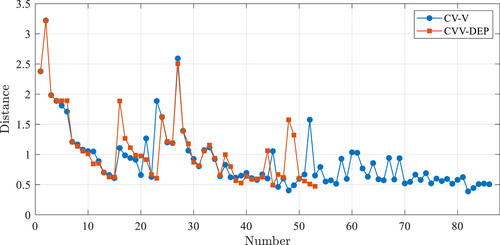
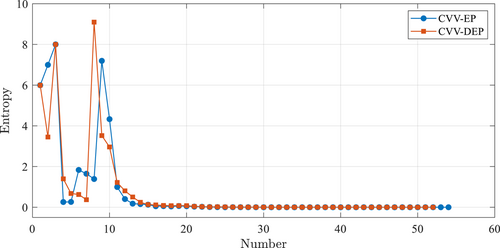
For the Kriging meta-models from three strategies after convergence, Figure 9 presents the variation of root-mean-square error (RMSE) for the 10,000 validation points. It can be observed that, despite similar trend as CV-V, CVV-DEP shows much earlier convergence. This implies that CVV-DEP enables less samples for the same accuracy of Kriging meta-model. CVV-EP, on the other hand, shows larger RMSE error than those of the other two but has similar convergence as CVV-DEP.
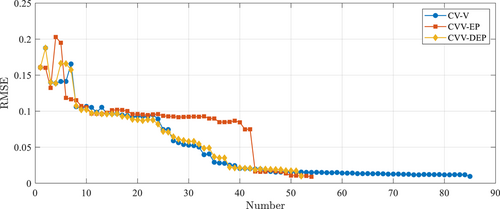
Figure 10 presents the final selected sample points and the partitions of sample space for the three strategies. Similar to Figure 7, CVV-DEP has a more obvious difference in the size of the selected sample unit when compared with CV-V. Compared with the actual image of F3 function in Figure 4, the samples selected by the CVV-DEP strategy are mostly concentrated in the part with relatively strong nonlinearity, while the unit sizes of the samples selected by the CV-V method are relatively uniform.

3.2 Results and discussion
Under the same convergence criterion, the six equations are run three times for each strategy, and the numbers of selected sample points are presented in Table 1. Due to weak nonlinearity, the total number of sample points is relatively small for all three strategies for the F1 function. For the F2 and F3 functions with strong nonlinearity, the total number of sample points decreased significantly for CVV-DEP and slightly for CVV-EP. F4 function has local extreme variation. As can be observed from Table 1, the total number of sample points for CVV-EP decreases a little more than CVV-DEP, indicating that considering EP could improve self-adaptation for function equations with local changes. For the F5 function, CVV-DEP enables effective balance between global expansion and local concentration by considering both distance and EP. F6 function has stronger nonlinearity, where all three strategies are observed to require more sample points than for other functions. The CVV-DEP shows slight better performance than the other two.
| Sampling strategy | |||
|---|---|---|---|
| Functional equation | CV-V | CVV-DEP | CVV-EP |
| F1 function | 9 | 7 | 7 |
| 9 | 8 | 7 | |
| 9 | 7 | 8 | |
| F2 function | 66 | 57 | 64 |
| 65 | 58 | 61 | |
| 67 | 59 | 64 | |
| F3 function | 86 | 53 | 55 |
| 77 | 53 | 67 | |
| 69 | 52 | 58 | |
| F4 function | 52 | 47 | 44 |
| 50 | 35 | 34 | |
| 64 | 52 | 45 | |
| F5 function | 89 | 79 | 95 |
| 93 | 77 | 96 | |
| 88 | 74 | 95 | |
| F6 function | 115 | 98 | 106 |
| 108 | 100 | 107 | |
| 97 | 93 | 96 | |
- Abbreviations: CV-V, cross validation-Voronoi; CVV-EP, cross validation-Voronoi and entropy; CVV-DEP, cross validation-Voronoi distance and entropy.
4 COMPUTATIONAL SIMULATION OF CVV-DEP FOR HYBRID SIMULATION
Computational simulation is further conducted to evaluate the efficacy of proposed CVV-DEP strategy for hybrid simulation to quantify uncertainty through limited number of laboratory experiments.
4.1 Nonlinear 2-DOF system

| Parameter | |||||||
|---|---|---|---|---|---|---|---|
| Value | |||||||
| Unit | - | - | - | - |
| Parameter | ||
|---|---|---|
| Range | [2 × 105 6 × 105] | [5 × 105 1.5 × 105] |
| Destitution | Uniform | Uniform |
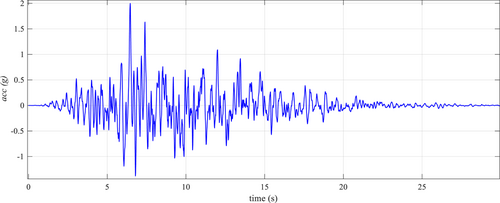
The initial sample points are selected as five and a total of 10,000 validation points are used to evaluate the accuracy of the final Kriging meta-model. The convergence condition is used for RMSE of validation points less than 0.01. To avoid the impact of random sampling, same set of candidate samples is used for all three strategies and a total of three runs are conducted for each strategy. Figure 13 presents the scatter plots of selected sample points to explore the difference in the adaptive sampling process. As can be observed, CVV-DEP has fewer sample points in the middle region with relatively flat response compared with the other two selection methods, and the sample points selected in the region with rapid change are basically the same as those of the other two methods. It shows that CVV-DEP can more effectively identify regions with strong nonlinearity.

Figure 14 presents the comparison between Kriging prediction and actual displacement response for the validation points. It can be observed that, after convergence is reached, all three adaptive strategies show excellent accuracy in Kriging prediction with the values of R2 close to 100%.

Figure 15 presents the variation of RMSE error for the three runs of adaptive sampling strategies. As can be observed that CVV-EP has greater oscillation than the other two. For the initial stage of the first and second run, single EP value is shown to have an adverse effect on RMSE, while at the initial stage of the third adaptive selection point, the single EP value had a favorable effect. This implies that the initial and candidate sample sets have big influence on the performance of CVV-EP at the early stage of sampling. On the other hand, the decreases of RMSE for CV-V and CVV-DEP are observed to steadier and more stable. Compared with CV-V, the CVV-DEP strategy has almost same decrease of RMSE but faster convergence. The total number of selected sample points are summarized in Figure 16 for all three strategies. As can be observed, CVV-DEP converges faster than both CV-V and CVV-EP.
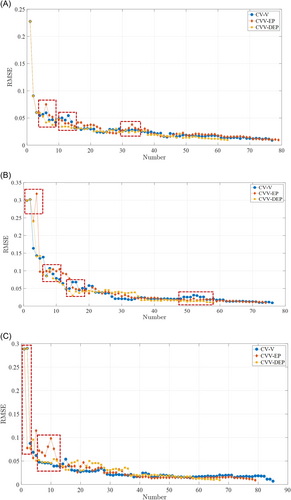
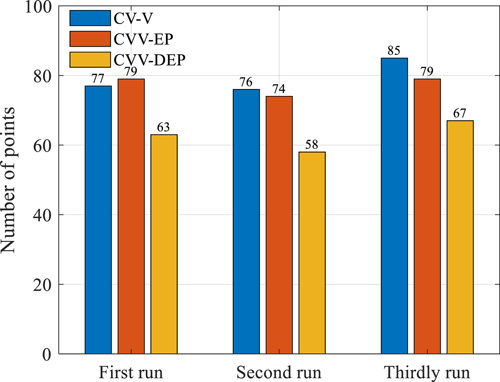
4.2 Maximum response of single-degree-of-freedom (SDOF) structure with self-centering viscous damper (SC-VD)
| Random variable | Distribution type | Mean | Standard deviation |
|---|---|---|---|
| Mass M (ton) | Gaussian | 200 | 20 |
| Stiffness kE (N/mm) | Gaussian |
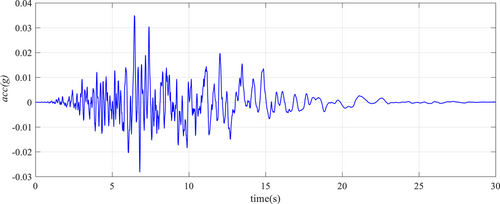
Similarly, three runs of computational simulation are conducted for all three strategies. However, different from previous application, the total number of sample points is set to be 50 to compare the variations in convergence. This is to accommodate the fact that each experimental research often has limited resource and time for laboratory testing. Taking the first run as an example, the final sampling point distribution is shown in Figure 18 for all three strategies.

Integrating EP and distance enables the CVV-DEP to have selected samples scattered more evenly in the beginning stage. Samples from CVV-EP and CV-V however are biased to the right first and then to the left, which might lead to less effectiveness in global exploration. In addition, the aggregation phenomenon of CVV-DEP and CVV-EP samples is more obvious than that of CV-V, and the distance between CV-V samples is relatively uniform. In practical engineering with strong local nonlinearity, CVV-DEP and CVV-EP are better than CV-V in local exploration.
Figure 19 shows the comparison between Kriging prediction and actual maximum displacement responses for validation sample points. Good agreement can be observed and the fitting R2 of the three methods are 98.27%, 98.19%, and 97.72%, respectively. This further proves that adaptive sampling using CVV-DEP is more accurate than the other two methods.

Figure 20 presents the variation of RMSE with the increase of sample points. The beginning three RMSE values are same for CVV-DEP and CV-V, indicating that the two strategies select the same sample points. The CVV-DEP is observed to have more stable decrease in RMSE that both CV-V and CVV-EP.
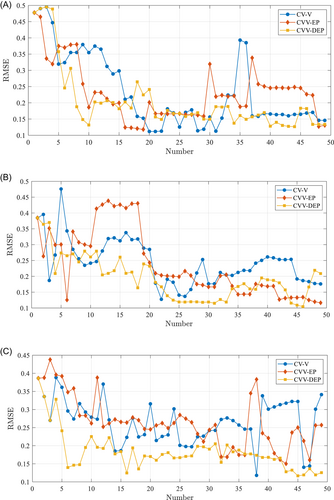
5 SUMMARY, CONCLUSIONS, AND FUTURE WORK
- (1)
Different improvement is observed in CVV-DEP for the numerical functions when compared with CV-V and CVV-EP. CVV-EP may require fewer learning sample points than CVV-DEP for functions with local extreme nonlinearity, indicating that adaptative sampling can be more effective when taking entropy into account.
- (2)
The EP value and the distance of selected sample points by CVV-DEP have the same trend of decrease as that of CV-V and CVV-EP. Integrating of EP value and distance enables sampling to be more concentrated in the region with strong nonlinearity.
- (3)
The distance between the final selected samples from CV-V is relatively uniform, while the aggregation phenomenon of the final selected samples from CVV-DEP and CVV-EP is more obvious implying for the effectiveness of CVV-DEP in identifying regions with strong nonlinearity of functional functions.
- (4)
The proposed CVV-DEP demonstrates better efficiency than CVV-EP and CV-V when integrated with hybrid simulation for global modeling of system response. For same convergence, CVV-DEP requires fewer samples than the other two.
In this study, the CVV-DEP adaptive sampling method is applied to the numerical simulation of hybrid simulation. Future research will experimentally evaluate this efficient adaptive sampling strategy to real-time hybrid simulation for uncertainty quantification for more realistic engineering structures. Future will focus on further optimization of adaptive sampling strategies and their experimental assessment.
NOMENCLATURES
-
-
- Acceleration history of selected ground motion;
-
- B
-
- Uniform modal damping;
-
-
- Damping parameters of the 2-DOF system;
-
- C
-
- Damping coefficient;
-
-
- Distance between candidate points and existing sample points;
-
-
- Prediction error of the cell;
-
- fd
-
- Damper measured restoring force;
-
-
- Restoring force of nonlinear spring;
-
-
- Basis functions of Kriging model;
-
-
- Unit vector;
-
-
- Stiffness parameters of the 2-DOF system;
-
- K1 and K2
-
- Initial and loading axial stiffness of the ring springs;
-
- kE
-
- Stiffness parameters of SDOF structure;
-
-
- Mass parameters of the 2-DOF system;
-
- M
-
- Mass parameters of SDOF structure;
-
- Pa
-
- Damper preload force;
-
-
- Correlation matrix of any two sample points and ;
-
-
- Correlation matrix for XA;
-
-
- Criteria for selecting sensitive cells;
-
-
- Criteria for selection of a new sample by EP method;
-
-
- Criteria for selection of a new sample by CVV-DEP method;
-
-
- Displacement of the 2-DOF system;
-
-
- Maximum absolute elongation;
-
- U
-
- Deformation of the damper;
-
- Ug
-
- Internal gap of the damper;
-
-
- Velocity of the 2-DOF system;
-
- x
-
- The input sample;
-
-
- The center point of a cell;
-
-
- The jth-dimensional input variable;
-
-
- Candidate sample set;
-
- XA
-
- Union of candidate samples and input samples;
-
-
- The response to data points;
-
-
- True response of ;
-
-
- Predicted value at of the meta-model without ;
-
-
- Regression coefficient of Kriging model;
-
-
- Correlation parameter of the correlation matrix;
-
-
- Predicted mean for sample point x;
-
-
- Predicted variance for sample point x.
ACKNOWLEDGMENT
This study effort was supported in part by the Ministry of Science and Technology of the People's Republic of China under Grant No. 2018YFE0206100.
CONFLICTS OF INTEREST
The authors declare no conflicts of interest.



